How to Decarbonize Greece by Comparing Wind and PV Energy: A Land Eligibility Analysis
Abstract
1. Introduction
2. Materials and Methods
2.1. Study Areas
2.2. Current State Analysis
2.3. Geospatial Land Availability for Energy Systems (GLAES)
2.4. Onshore Wind Land Eligibility Analysis
2.5. Open-Field PV Land Eligibility Analysis
2.6. Deserted Lignite Mine Potential
3. Results
3.1. Current State of Wind Turbines and PV Power Plants
3.2. Onshore Wind Potential
3.3. Open-Field PV Potential
3.4. Renewables’ Potential of Decommissioned Lignite Mines
4. Discussion
4.1. Comparison between the GLAES-Defined Eligible Areas with the Current State
4.2. Comparison of the Wind and Solar PV Energy Potential in the Mining Areas under Study
4.3. Limitations
5. Conclusions
Author Contributions
Funding
Data Availability Statement
Conflicts of Interest
Abbreviations
| DEM | Digital Elevation Model |
| GLAES | Geospatial Land Availability for Energy Systems |
| GHI | Global Horizontal Irradiation |
| GIS | Geographic Information System |
| NECP | National Energy and Climate Plan |
| PV | Photovoltaic |
| RES | Renewable Energy Source |
| WPD | Wind Power Density |
| SFSPSD-RES | Specific Framework for Spatial Planning and Sustainable Development for Renewable Energy Sources |
References
- United Nations. Paris Agreement; United Nations: Paris, France, 2015. [Google Scholar]
- Kaldellis, J.K.; Kapsali, M.; Katsanou, E. Renewable Energy Applications in Greece—What Is the Public Attitude? Energy Policy 2012, 42, 37–48. [Google Scholar] [CrossRef]
- IEA. Energy Policy Review Greece 2023. Available online: https://iea.blob.core.windows.net/assets/5dc74a29-c4cb-4cde-97e0-9e218c58c6fd/Greece2023.pdf (accessed on 26 June 2023).
- Central Intelligence Agency Greece Country Summary. Available online: https://www.cia.gov/the-world-factbook/countries/greece/#energy (accessed on 27 June 2023).
- IEA 2023. Greece—Countries & Regions. Available online: https://www.iea.org/countries/greece (accessed on 30 December 2023).
- Mourmouris, J.C.; Potolias, C. A Multi-Criteria Methodology for Energy Planning and Developing Renewable Energy Sources at a Regional Level: A Case Study Thassos, Greece. Energy Policy 2013, 52, 522–530. [Google Scholar] [CrossRef]
- Tsoutsos, T.; Tsitoura, I.; Kokologos, D.; Kalaitzakis, K. Sustainable Siting Process in Large Wind Farms Case Study in Crete. Renew. Energy 2015, 75, 474–480. [Google Scholar] [CrossRef]
- Latinopoulos, D.; Kechagia, K. A GIS-Based Multi-Criteria Evaluation for Wind Farm Site Selection. A Regional Scale Application in Greece. Renew. Energy 2015, 78, 550–560. [Google Scholar] [CrossRef]
- Bili, A.; Vagiona, D.G. Use of Multicriteria Analysis and GIS for Selecting Sites for Onshore Wind Farms: The Case of Andros Island (Greece). Eur. J. Environ. Sci. 2018, 8, 5–13. [Google Scholar] [CrossRef]
- Karamountzou, S.; Vagiona, D.G. Suitability and Sustainability Assessment of Existing Onshore Wind Farms in Greece. Sustainability 2023, 15, 2095. [Google Scholar] [CrossRef]
- Vagiona, D.G. Comparative Multicriteria Analysis Methods for Ranking Sites for Solar Farm Deployment: A Case Study in Greece. Energies 2021, 14, 8371. [Google Scholar] [CrossRef]
- Greece. Available online: https://www.britannica.com/place/Greece (accessed on 26 June 2023).
- National Archive of Monuments. Available online: https://www.arxaiologikoktimatologio.gov.gr/ (accessed on 26 June 2023).
- Natura 2000 Viewer. Available online: https://natura2000.eea.europa.eu/ (accessed on 26 June 2023).
- Regions of Greece. Available online: https://geodata.gov.gr/en/dataset/periphereies-elladas (accessed on 26 June 2023).
- Baltas, A.E.; Dervos, A.N. Special Framework for the Spatial Planning & the Sustainable Development of Renewable Energy Sources. Renew. Energy 2012, 48, 358–363. [Google Scholar] [CrossRef]
- Ryberg, D.S.; Tulemat, Z.; Robinius, M.; Stolten, D. Geospatial Land Availability for Energy Systems (GLAES). Available online: https://github.com/FZJ-IEK3-VSA/glaes (accessed on 23 June 2023).
- European Evironment Agency Digital Elevation Model over Europe. Available online: https://www.eea.europa.eu/data-and-maps/data/eu-dem (accessed on 28 June 2023).
- Global Wind Atlas. Available online: https://globalwindatlas.info/en/ (accessed on 26 June 2023).
- Global Solar Atlas. Available online: https://globalsolaratlas.info/global-pv-potential-study (accessed on 26 June 2023).
- RAE Geospatial Map for Energy Units & Requests. Available online: https://geo.rae.gr/?tab=viewport_maptab (accessed on 27 June 2023).
- Iqbal, M.; Azam, M.; Naeem, M.; Khwaja, A.S.; Anpalagan, A. Optimization Classification, Algorithms and Tools for Renewable Energy: A Review. Renew. Sustain. Energy Rev. 2014, 39, 640–654. [Google Scholar] [CrossRef]
- Ryberg, D.S.; Robinius, M.; Stolten, D. Methodological Framework for Determining the Land Eligibility of Renewable Energy Sources. arXiv 2017, arXiv:1712.07840. [Google Scholar]
- European Environment Agency Europe’s Onshore and Offshore Wind Energy Potential: An Assessment of Environmental and Economic Constraints; Publications Office: Luxembourg, 2009.
- McKenna, R.; Hollnaicher, S.; Ostman, V.D.; Leye, P.; Fichtner, W. Cost-Potentials for Large Onshore Wind Turbines in Europe. Energy 2015, 83, 217–229. [Google Scholar] [CrossRef]
- Eurek, K.; Sullivan, P.; Gleason, M.; Hettinger, D.; Heimiller, D.; Lopez, A. An Improved Global Wind Resource Estimate for Integrated Assessment Models. Energy Econ. 2017, 64, 552–567. [Google Scholar] [CrossRef]
- Ryberg, D.S.; Tulemat, Z.; Stolten, D.; Robinius, M. Uniformly Constrained Land Eligibility for Onshore European Wind Power. Renew. Energy 2020, 146, 921–931. [Google Scholar] [CrossRef]
- Ryberg, D.S. Generation Lulls from the Future Potential of Wind and Solar Energy in Europe. 2020, pp. 96–109. Available online: https://publications.rwth-aachen.de/record/805445 (accessed on 12 June 2023).
- GISCO Corine Land Cover V2012 2012. Available online: https://land.copernicus.eu/pan-european/corine-land-cover/clc-2012 (accessed on 12 July 2023).
- GISCO Clusters: Urban 2011 2016. Available online: http://ec.europa.eu/eurostat/web/gisco/geodata/reference-data/elevation/hydrography-laea (accessed on 12 July 2023).
- OpenStreetMap Contributors Planet Dump 2017. Available online: https://planet.osm.org (accessed on 12 July 2023).
- UNEP-WCMC and IUCN Protected Planet: The World Database on Protected Areas (WDPA) 2016. Available online: https://www.protectedplanet.net/en/search-areas?filters%5Bdb_type%5D%5B%5D=wdpa&geo_type=region (accessed on 12 July 2023).
- Baseer, M.A.; Rehman, S.; Meyer, J.P.; Alam, M.M. GIS-Based Site Suitability Analysis for Wind Farm Development in Saudi Arabia. Energy 2017, 141, 1166–1176. [Google Scholar] [CrossRef]
- Sánchez-Lozano, J.M.; García-Cascales, M.S.; Lamata, M.T. Identification and Selection of Potential Sites for Onshore Wind Farms Development in Region of Murcia, Spain. Energy 2014, 73, 311–324. [Google Scholar] [CrossRef]
- Ayodele, T.R.; Ogunjuyigbe, A.S.O.; Odigie, O.; Munda, J.L. A Multi-Criteria GIS Based Model for Wind Farm Site Selection Using Interval Type-2 Fuzzy Analytic Hierarchy Process: The Case Study of Nigeria. Appl. Energy 2018, 228, 1853–1869. [Google Scholar] [CrossRef]
- Höfer, T.; Sunak, Y.; Siddique, H.; Madlener, R. Wind Farm Siting Using a Spatial Analytic Hierarchy Process Approach: A Case Study of the Städteregion Aachen. Appl. Energy 2016, 163, 222–243. [Google Scholar] [CrossRef]
- Tlili, O.; Mansilla, C.; Robinius, M.; Ryberg, D.S.; Caglayan, D.G.; Linssen, J.; André, J.; Perez, Y.; Stolten, D. Downscaling of Future National Capacity Scenarios of the French Electricity System to the Regional Level. Energy Syst. 2022, 13, 137–165. [Google Scholar] [CrossRef]
- Réfet de la Région Nord-Pas-de-Calais Annexe: ‘Schéma Régional Eolien’. Available online: https://www.hauts-de-france.developpement-durable.gouv.fr/IMG/pdf/sre_et_srs_npdc-2.pdf (accessed on 16 August 2023).
- Maestre, V.M.; Ortiz, A.; Ortiz, I. Transition to a Low-Carbon Building Stock. Techno-Economic and Spatial Optimization of Renewables-hydrogen Strategies in Spain. J. Energy Storage 2022, 56, 105889. [Google Scholar] [CrossRef]
- Colak, H.E.; Memisoglu, T.; Gercek, Y. Optimal Site Selection for Solar Photovoltaic (PV) Power Plants Using GIS and AHP: A Case Study of Malatya Province, Turkey. Renew. Energy 2020, 149, 565–576. [Google Scholar] [CrossRef]
- Günen, M.A. Determination of the Suitable Sites for Constructing Solar Photovoltaic (PV) Power Plants in Kayseri, Turkey Using GIS-Based Ranking and AHP Methods. Environ. Sci. Pollut. Res. 2021, 28, 57232–57247. [Google Scholar] [CrossRef]
- Kocabaldır, C.; Yücel, M.A. GIS-Based Multicriteria Decision Analysis for Spatial Planning of Solar Photovoltaic Power Plants in Çanakkale Province, Turkey. Renew. Energy 2023, 212, 455–467. [Google Scholar] [CrossRef]
- Tercan, E.; Saracoglu, B.O.; Bilgilioğlu, S.S.; Eymen, A.; Tapkın, S. Geographic Information System-Based Investment System for Photovoltaic Power Plants Location Analysis in Turkey. Environ. Monit. Assess. 2020, 192, 297. [Google Scholar] [CrossRef] [PubMed]
- Perpiña Castillo, C.; Batista E Silva, F.; Lavalle, C. An Assessment of the Regional Potential for Solar Power Generation in EU-28. Energy Policy 2016, 88, 86–99. [Google Scholar] [CrossRef]
- Yousefi, H.; Hafeznia, H.; Yousefi-Sahzabi, A. Spatial Site Selection for Solar Power Plants Using a GIS-Based Boolean-Fuzzy Logic Model: A Case Study of Markazi Province, Iran. Energies 2018, 11, 1648. [Google Scholar] [CrossRef]
- National Energy and Climate Plan; HELLENIC REPUBLIC Ministry of the Environment and Energy: Athens, Greece, 2019.
- Argyropoulos, D. Coal, on Its Way out—Greece’s Plans to Phase out Lignite Are Boosted by the Pandemic. 2020. Available online: https://energytransition.org/2020/09/coal-on-its-way-out-how-the-greek-plans-to-phase-out-lignite-are-boosted-by-the-pandemic/ (accessed on 5 July 2023).
- Liaggou, C. PPC Extends Operation of Seven Lignite Units to Ensure Supply 2021. Available online: https://www.ekathimerini.com/economy/1174648/ppc-extends-operation-of-seven-lignite-units-to-ensure-supply/ (accessed on 5 July 2023).
- Chatzitheodoridis, F.; Kolokontes, A.D.; Vasiliadis, L. Lignite Mining and Lignite-Fired Power Generation in Western Macedonia of Greece: Economy and Environment. J. Energy Dev. 2023, 33, 267–282. [Google Scholar]
- 2022 Annual Statistics of Wind Farms 2023. Available online: https://resinvest.gr/2023/02/01/2022-annual-statistics-hellenic-wind-energy-association-2/ (accessed on 7 July 2023).
- Petrova, V. Greece Adds Record 1.4 GW of Fresh Solar in 2022—Report 2023. Available online: https://renewablesnow.com/news/greece-adds-record-14-gw-of-fresh-solar-in-2022-report-818214/ (accessed on 7 July 2023).
- Suri, M.; Betak, J.; Rosina, K.; Chrkavy, D.; Suriova, N.; Cebecaue, T.; Caltik, M.; Erdelyi, B. Global Photovoltaic Power Potential by Country (English); Energy Sector Management Assistance Program (ESMAP): Washington, DC, USA; World Bank Group: Washington, DC, USA, 2020. [Google Scholar]
- 30 Years of Policies for Wind Energy: Lessons from Greece; International Renewable Energy Agency. Available online: https://www.irena.org/publications/2013/Jan/30-Years-of-Policies-for-Wind-Energy-Lessons-from-12-Wind-Energy-Markets (accessed on 9 July 2023).
- Greek PV Market Investment Opportunities. Hellenic Association of Photovoltaic Companies. Available online: https://helapco.gr/pdf/Greek_PV_Market_Opportunities_Aug2019.pdf (accessed on 10 January 2024).
- Schmidt, O.; Melchior, S.; Hawkes, A.; Staffell, I. Projecting the Future Levelized Cost of Electricity Storage Technologies. Joule 2019, 3, 81–100. [Google Scholar] [CrossRef]
- Tassenoy, R.; Couvreur, K.; Beyne, W.; De Paepe, M.; Lecompte, S. Techno-Economic Assessment of Carnot Batteries for Load-Shifting of Solar PV Production of an Office Building. Renew. Energy 2022, 199, 1133–1144. [Google Scholar] [CrossRef]
- Aposporis, H. Solar Power Capacity in Greece Overtakes Wind for First Time 2022. Available online: https://balkangreenenergynews.com/solar-power-capacity-in-greece-overtakes-wind-for-first-time/ (accessed on 10 July 2023).
- Creutzig, F.; Hilaire, J.; Nemet, G.; Müller-Hansen, F.; Minx, J.C. Technological Innovation Enables Low Cost Climate Change Mitigation. Energy Res. Soc. Sci. 2023, 105, 103276. [Google Scholar] [CrossRef]
- Kougioumoutzis, K.; Kokkoris, I.; Panitsa, M.; Kallimanis, A.; Strid, A.; Dimopoulos, P. Plant Endemism Centres and Biodiversity Hotspots in Greece. Biology 2021, 10, 72. [Google Scholar] [CrossRef]
- Hu, W.; Scholz, Y.; Yeligeti, M.; Bremen, L.V.; Deng, Y. Downscaling ERA5 Wind Speed Data: A Machine Learning Approach Considering Topographic Influences. Environ. Res. Lett. 2023, 18, 094007. [Google Scholar] [CrossRef]
- Antoniadis, A.; Roumpos, C.; Anagnostopoulos, P.; Paraskevis, N. Planning RES Projects in Exhausted Surface Lignite Mines—Challenges and Solutions. In Proceedings of the International Conference on Raw Materials and Circular Economy, Athens, Greece, 5–9 September 2021; p. 93. [Google Scholar]
- Knauber, S. RWE and PPC to Build Solar Projects with 280 Megawatts of Capacity in Greece. Available online: https://www.rwe.com/en/press/rwe-renewables-europe-australia/23-07-31-rwe-and-ppc-to-build-solar-projects-with-280-mw-of-capacity-in-greece/ (accessed on 10 December 2023).
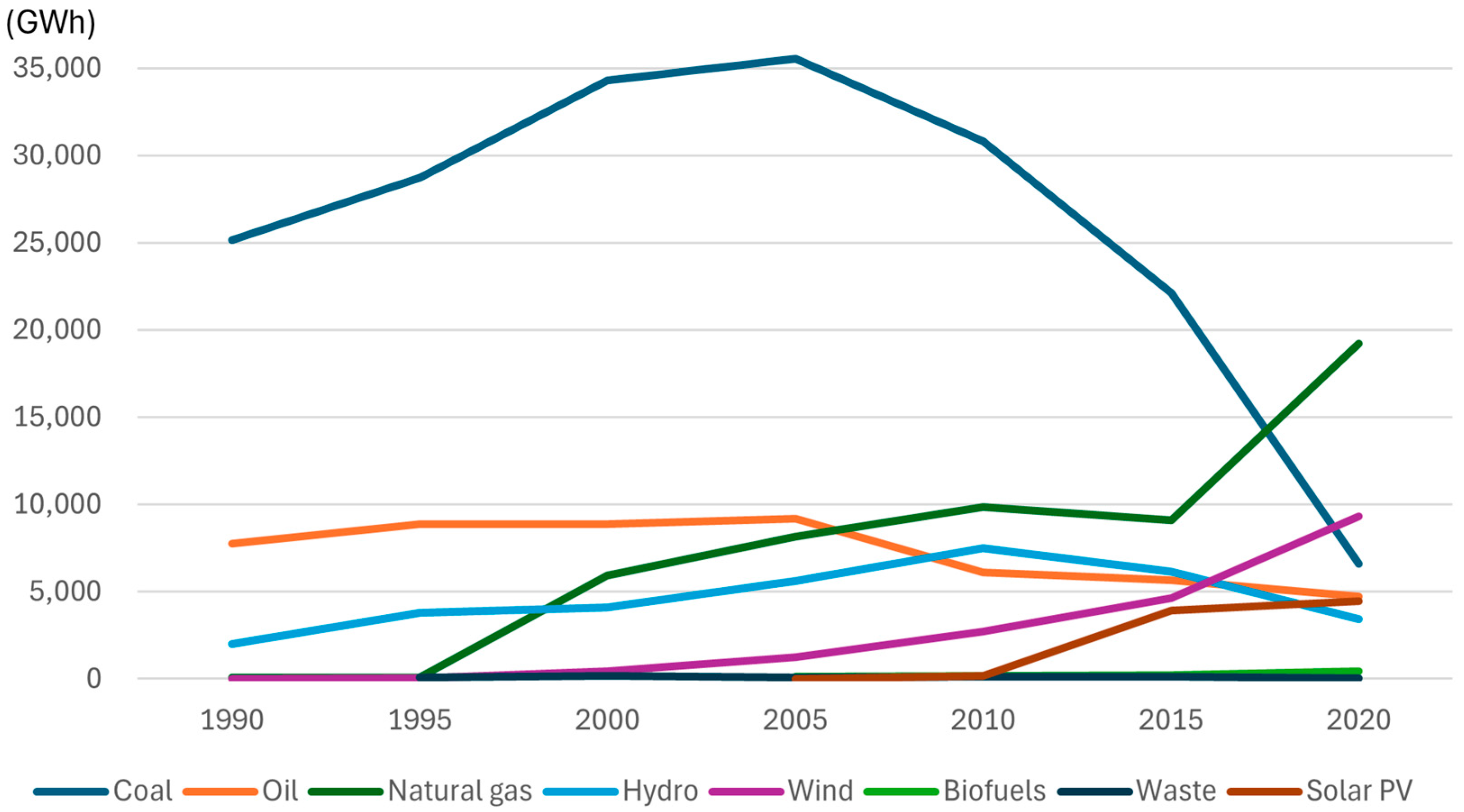



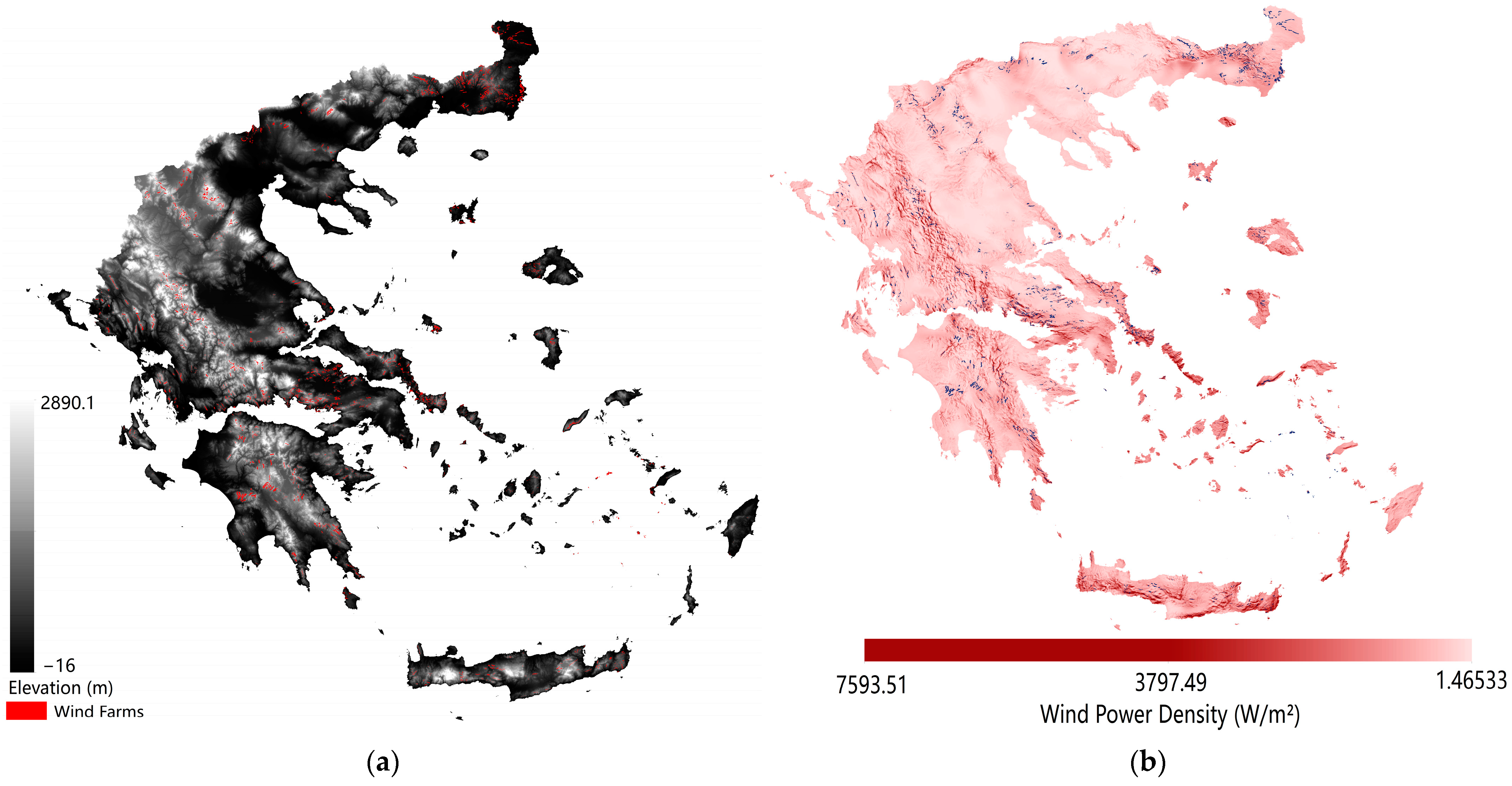

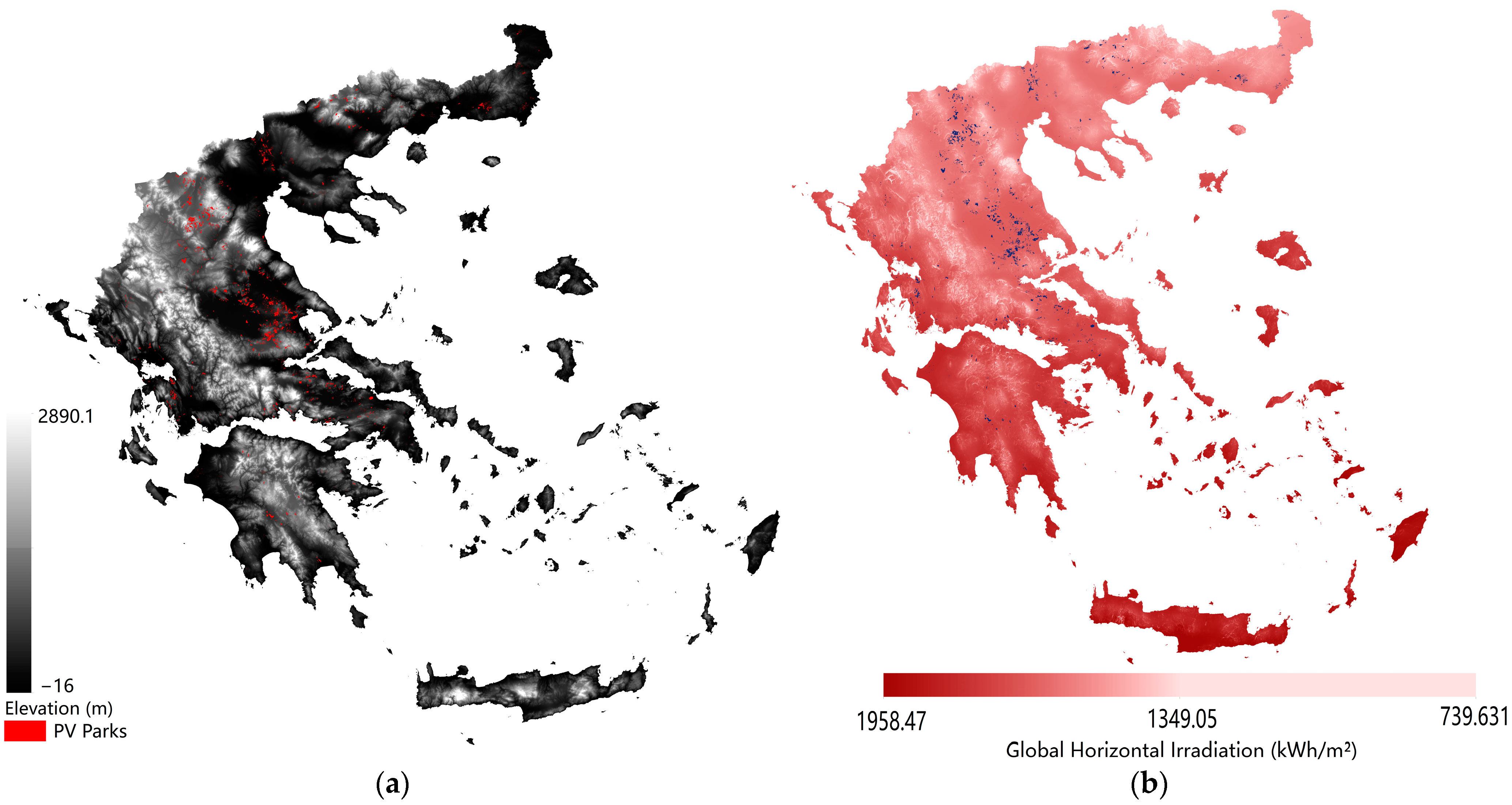
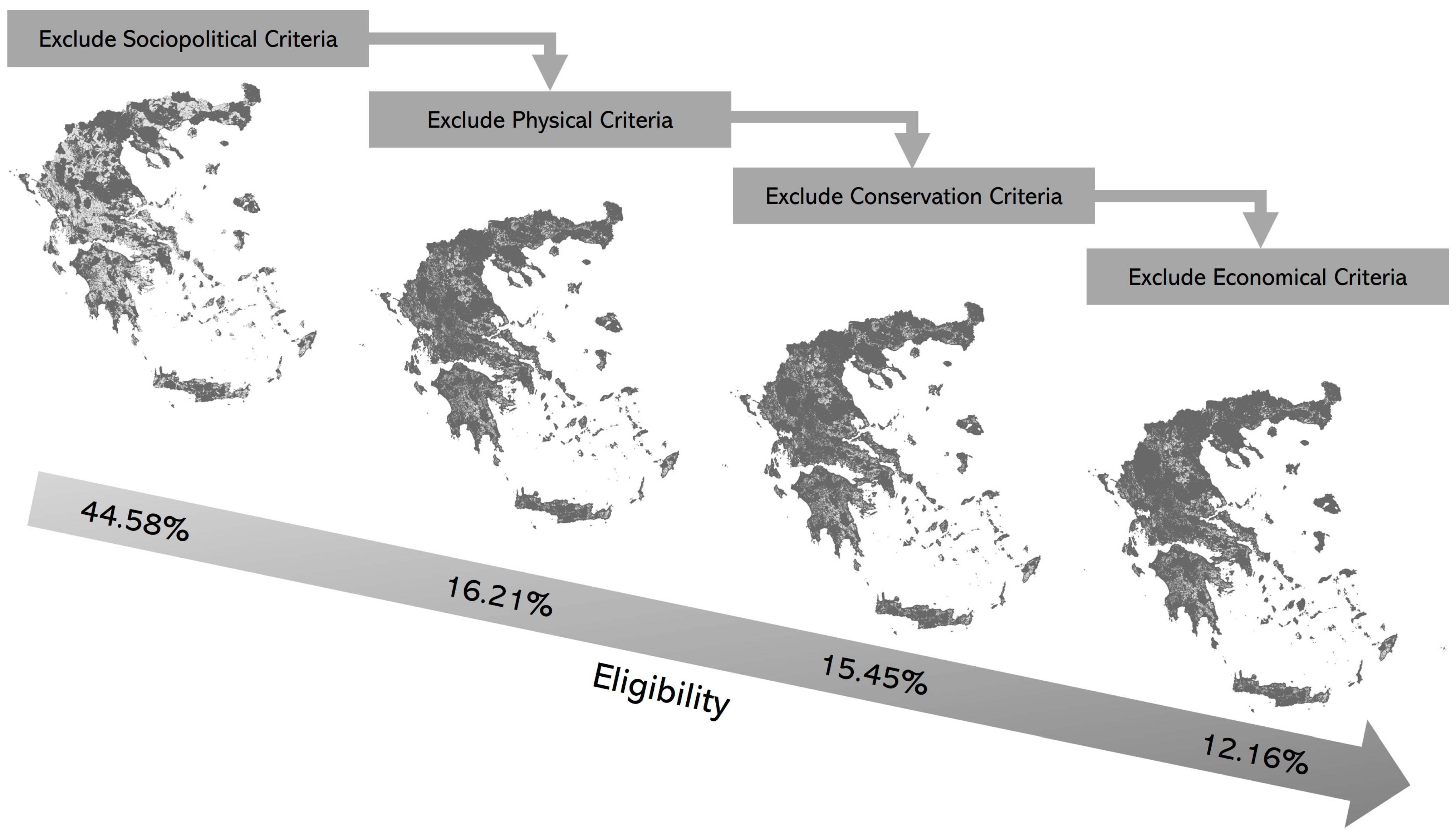
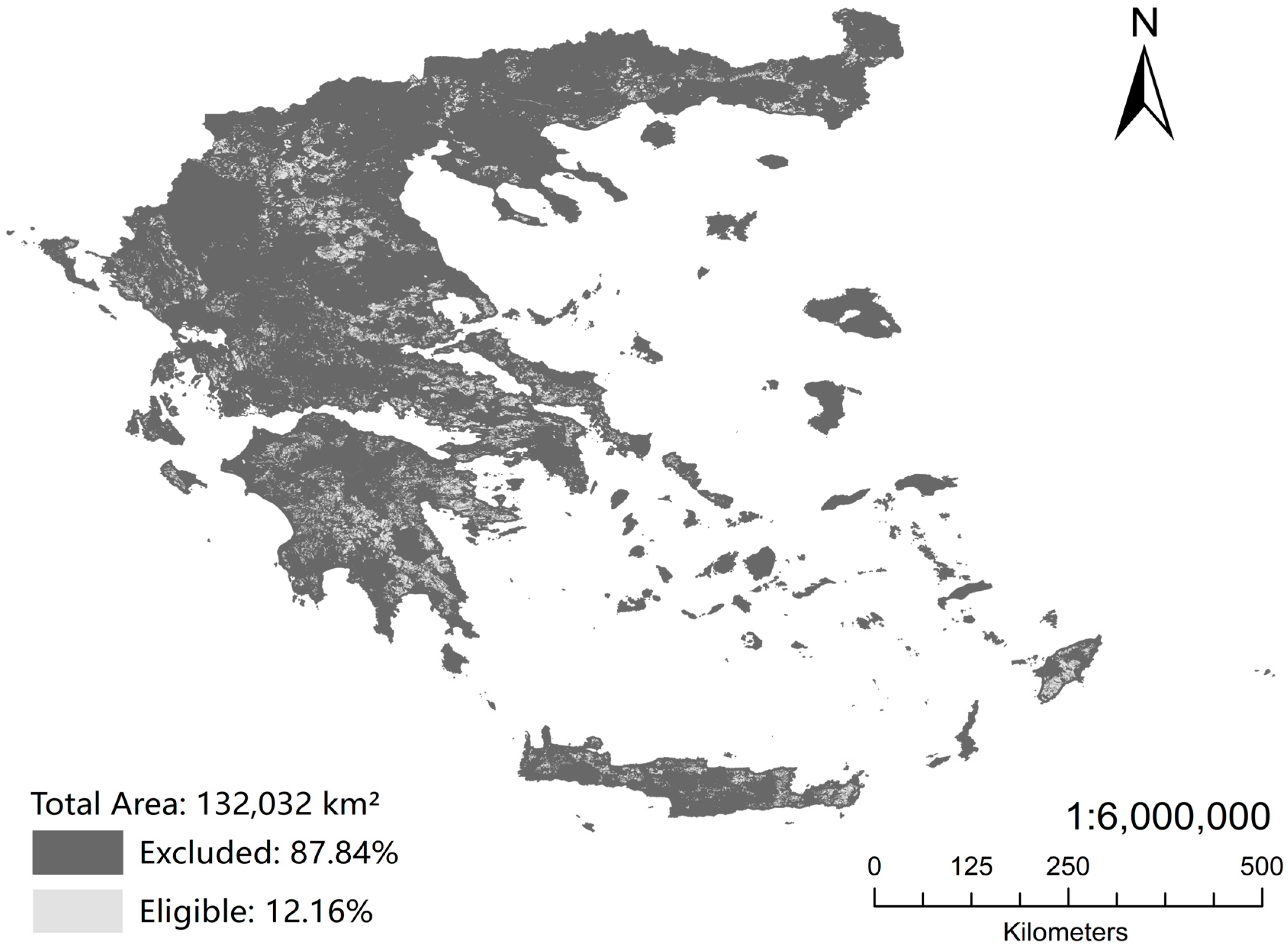
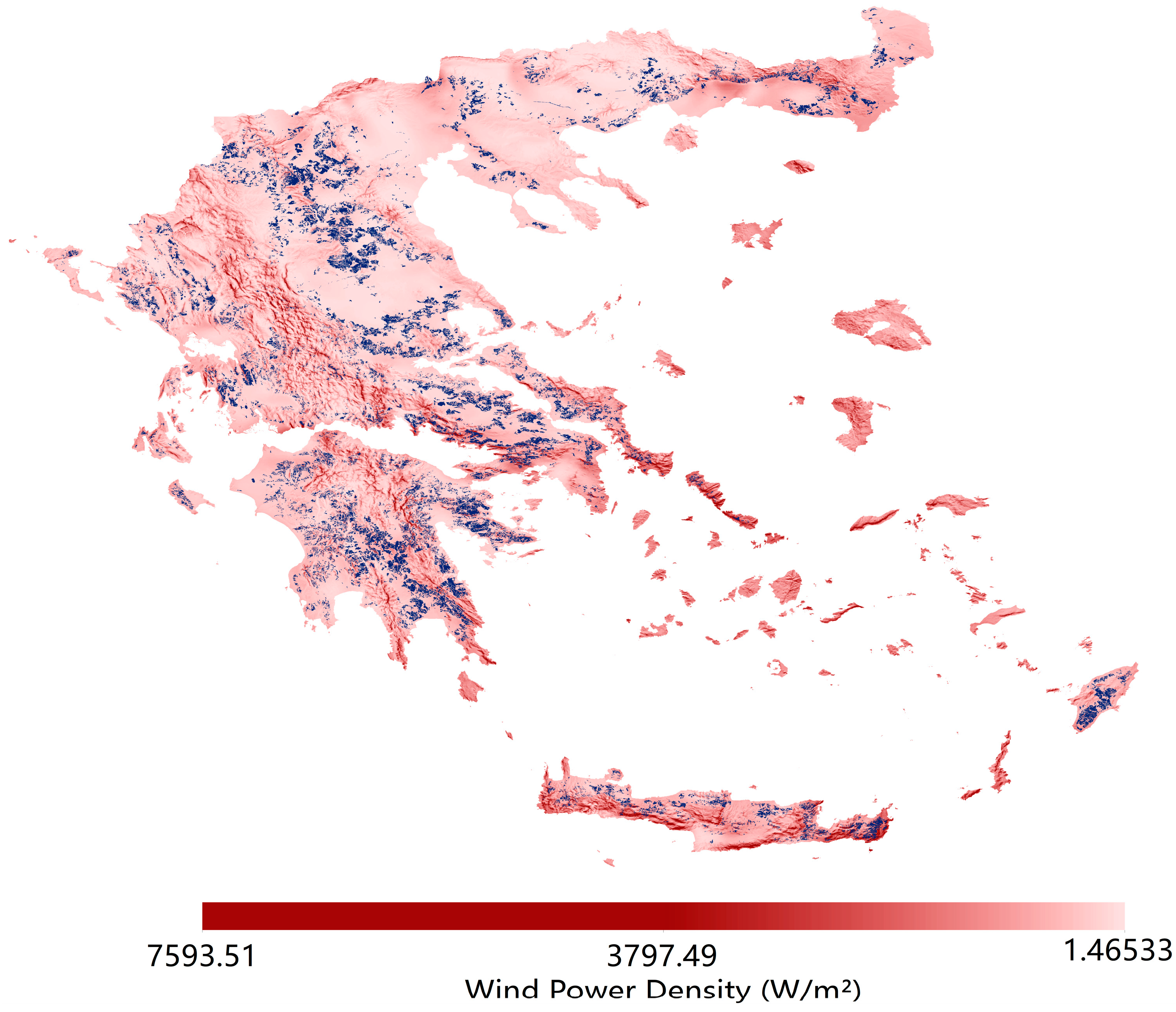
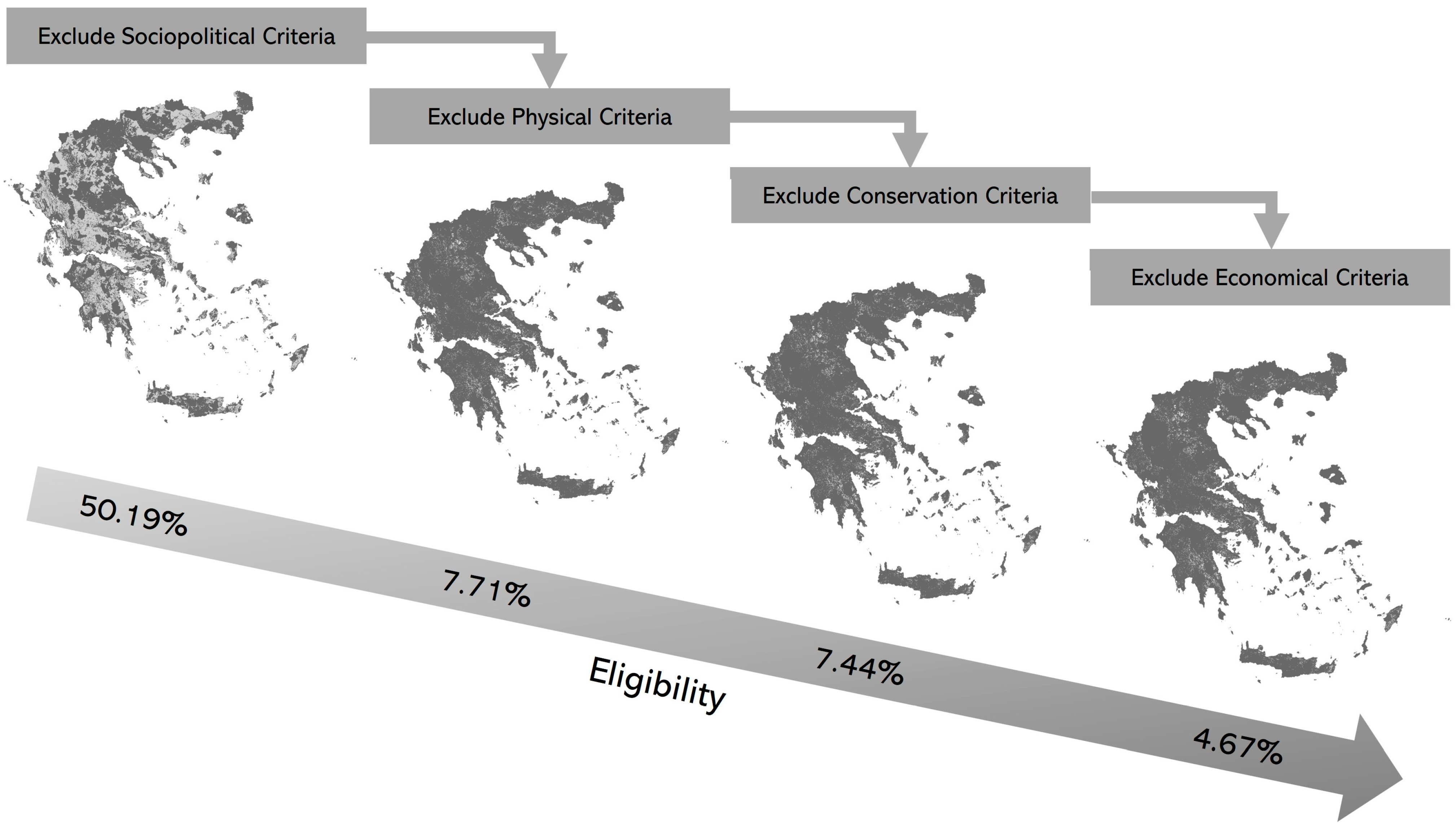
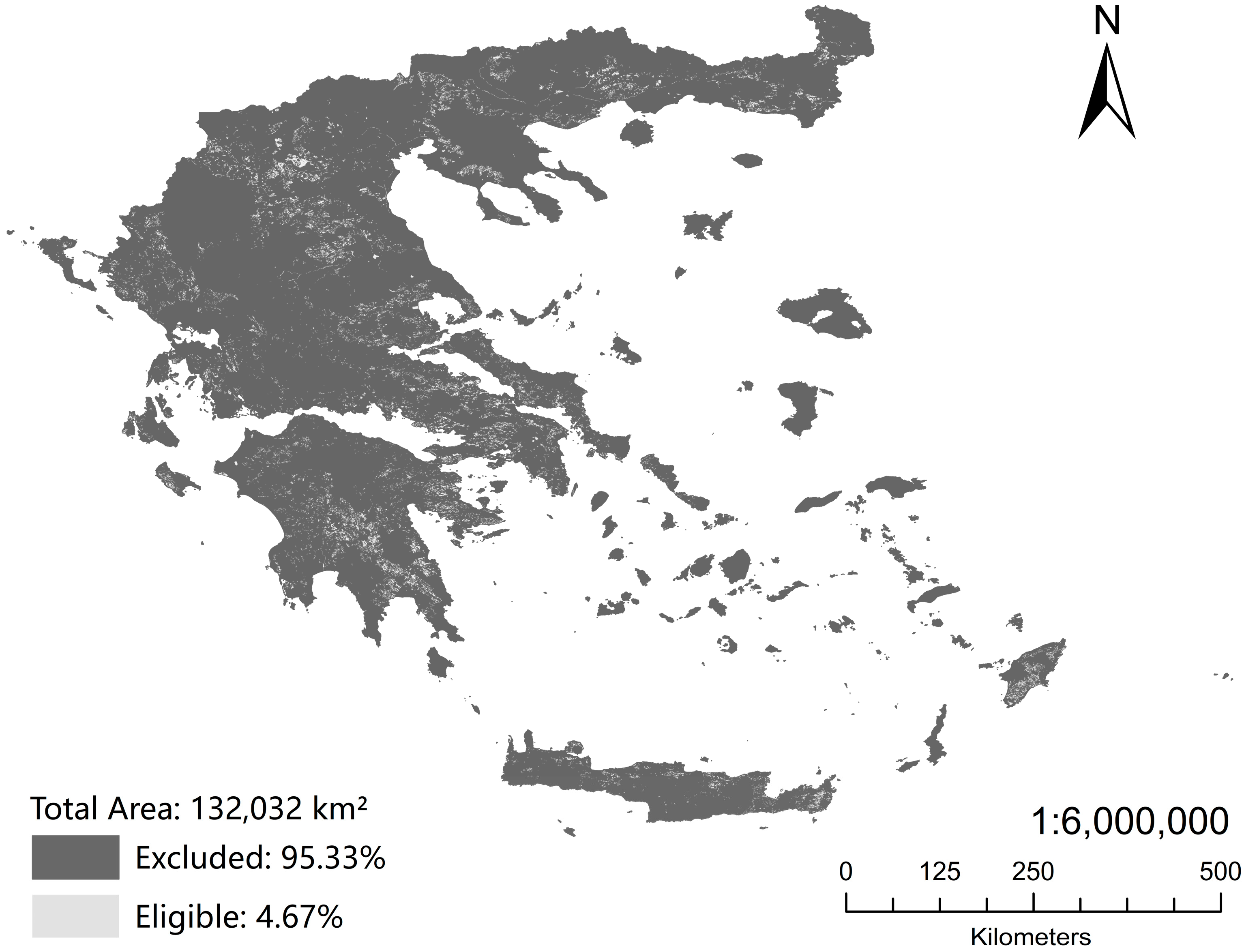
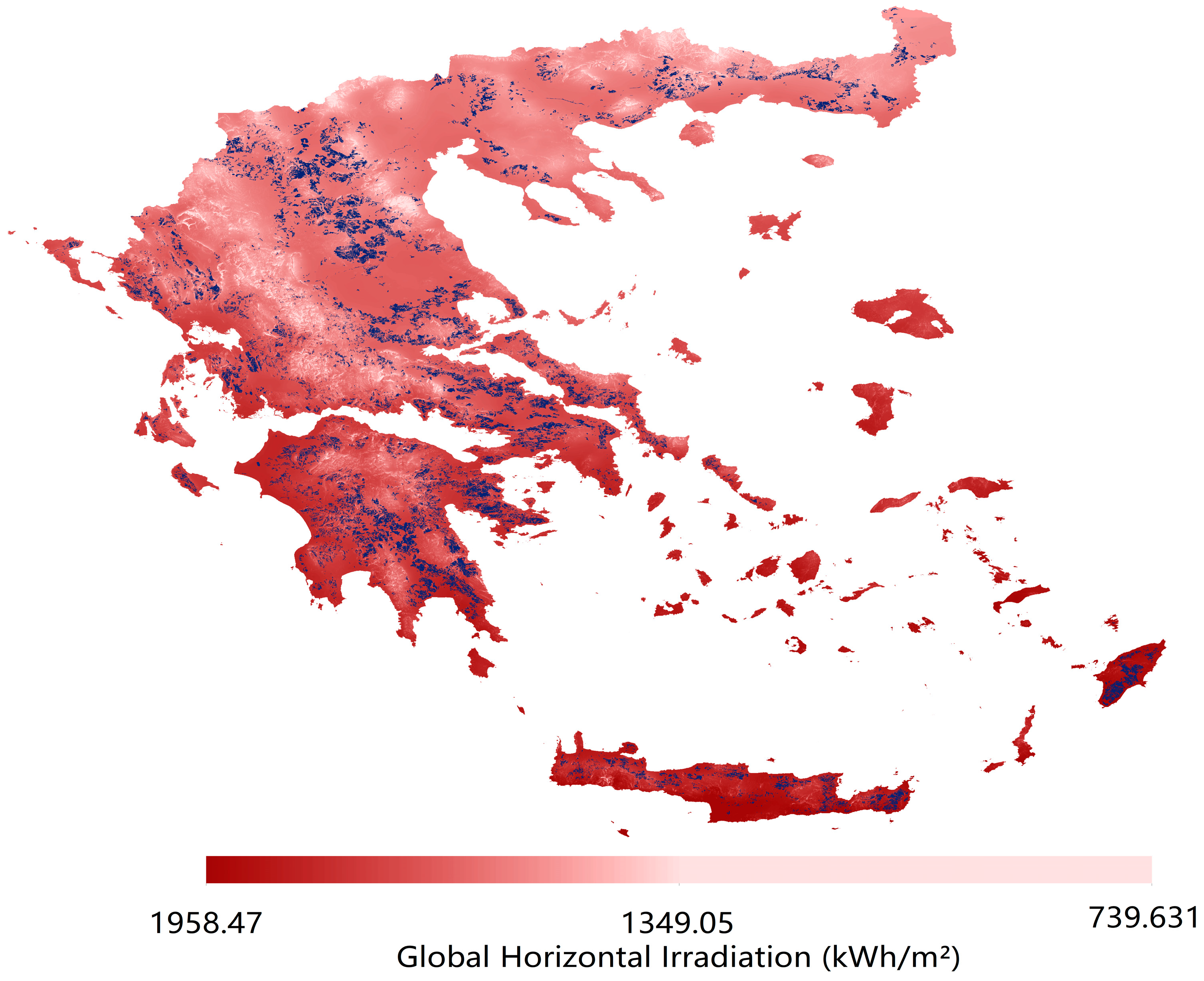
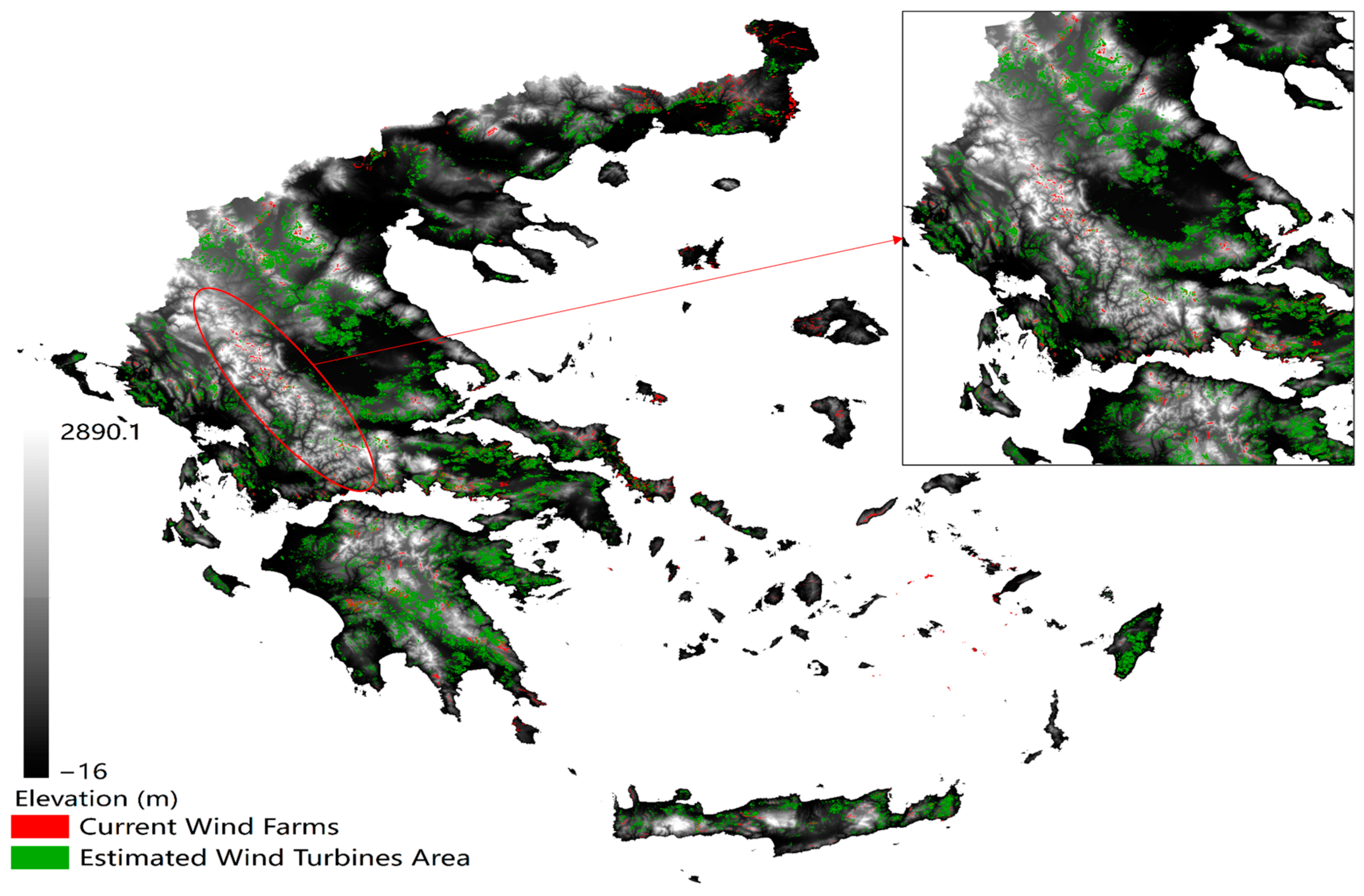
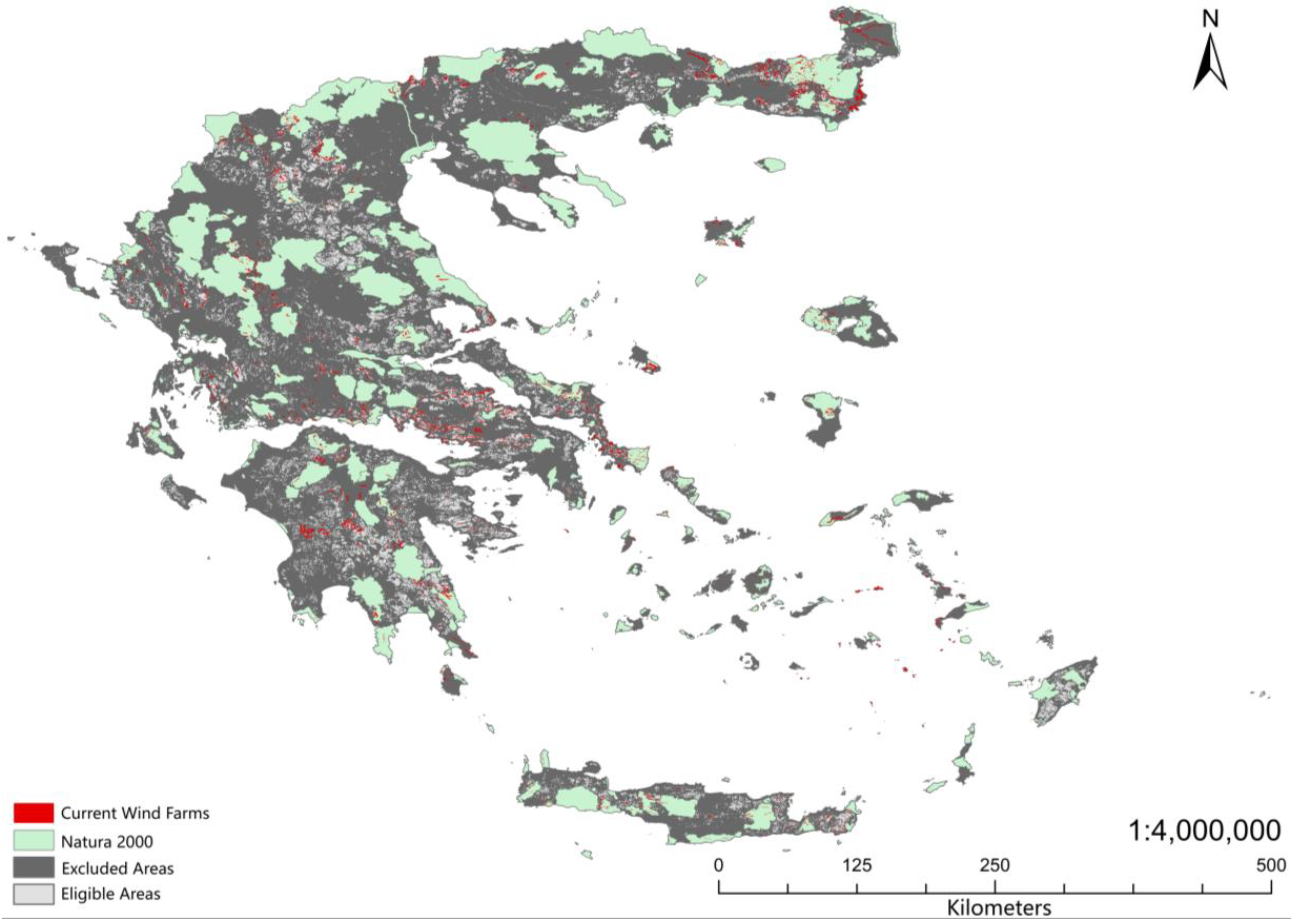
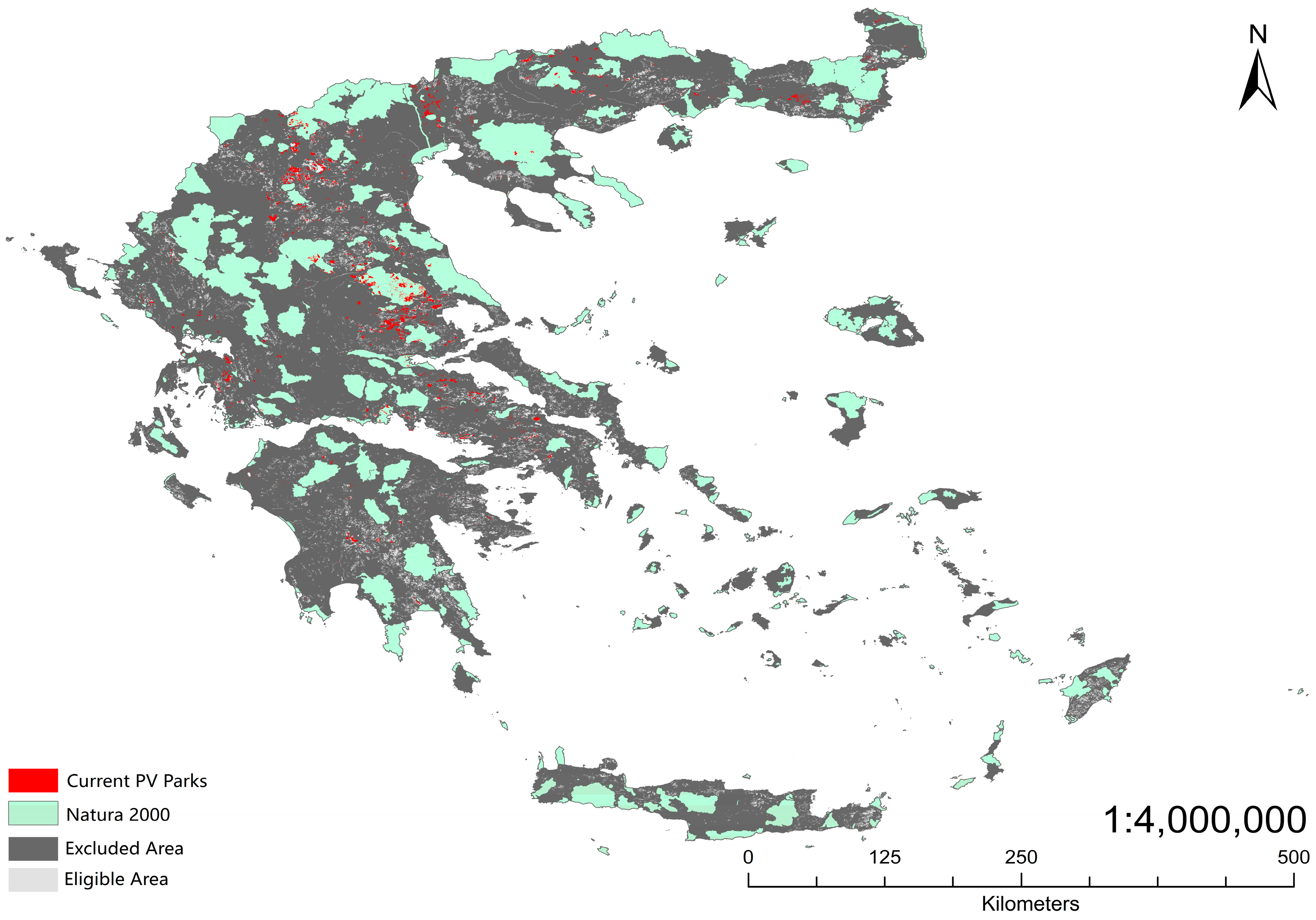


| Constraint | Threshold | Data Source |
|---|---|---|
| Socio-political: | ||
| Distance from Rural Settlements | >500 m | CLC [29] |
| Distance from Urban Settlements | >1000 m | EuroStat [30] |
| Distance from Roadways | >120 m | Open Street Map [31] |
| Distance from Railways | >120 m | Open Street Map [31] |
| Distance from Power Lines | >120 m | Open Street Map [31] |
| Distance from Touristic Areas | >1500 m | Open Street Map [31] |
| Distance from Airports | >3000 m | CLC [29], EuroStat [30] |
| Distance from Agricultural Areas | Excluded | CLC [29] |
| Physical: | ||
| Terrain Slope | <17° | EuroDEM [18] |
| Distance from Coastlines | >1500 m | CLC [29] |
| Distance from Sandy Areas | Excluded | CLC [29] |
| Distance from Woodlands | Excluded | CLC [29] |
| Distance from Waterbodies | Excluded | CLC [29] |
| Distance from Rivers | Excluded | EuroStat [30] |
| Distance from Wetlands | Excluded | CLC [29] |
| Conservation: | ||
| Distance from Natural Monuments | >800 m | WDPA [32] |
| Distance from Parks | >800 m | WDPA [32] |
| Distance from Landscapes | >1000 m | WDPA [32] |
| Natura 2000 Areas | Excluded | Natura 2000 [14] |
| Economic: | ||
| Wind Speed | <4 m/s | Global Wind Atlas [19] |
| Access Distance | <5 km | Open Street Map [31] |
| Connection Distance | <20 km | Open Street Map [31] |
| Parameter | Value |
|---|---|
| Hub Height | 120 m |
| Rotor Diameter | 136 m |
| Capacity | 4200 kW |
| Specific Power | 289 W/m2 |
| Constraint | Threshold | Data Source |
|---|---|---|
| Socio-political: | ||
| Distance from Settlements | >200 m | CLC [29] |
| Distance from Airports | >2000 m | CLC [29], EuroStat [30] |
| Distance from Industrial Areas | Excluded | CLC [29] |
| Distance from Agricultural Areas | Excluded | CLC [29] |
| Physical: | ||
| Terrain Slope: Total | <10° | EuroDEM [18] |
| Terrain Slope: Northward | <3° | EuroDEM [18] |
| Distance from Elevation | <1500 m | EuroDEM [18] |
| Distance from Waterbodies | >500 m | CLC [29] |
| Distance from Woodlands | Excluded | CLC [29] |
| Distance from Wetlands | Excluded | CLC [29] |
| Distance from Coastlines | Excluded | CLC [29] |
| Distance from Sandy Areas | Excluded | CLC [29] |
| Conservation: | ||
| Distance from Natural Monuments | >200 m | WDPA [32] |
| Distance from Landscapes | Excluded | WDPA [32] |
| Distance from Parks | Excluded | WDPA [32] |
| Natura 2000 Areas | Excluded | Natura 2000 [14] |
| Economic: | ||
| Connection Distance | <20 km | Open Street Map [31] |
| Access Distance | <10 km | Open Street Map [31] |
| Parameter | Value |
|---|---|
| Max Power | 240.4 W |
| Area | 1.663 m2 |
| Technology | Polycrystalline |
| Lignite Mine | Megalopoli | Ptolemaida I | Ptolemaida II | Total |
|---|---|---|---|---|
| Wind: | ||||
| Wind Turbines | 34 | 155 | 61 | 250 |
| Wind Turbine Power (kW) | 4200 | 4200 | 4200 | |
| Energy Yield (kWh/kW) | 3000 | 3000 | 3000 | |
| Wind Energy Potential (GWh) | 428 | 1953 | 769 | 3150 |
| Solar: | ||||
| PV Parks | 21 | 102 | 37 | 160 |
| Area for PV (km2) | 11.5 | 68.9 | 22.1 | 102.5 |
| PV Peak Power (GWp) | 1.7 | 9.9 | 3.2 | |
| Energy Yield (kWh/kWp) | 1400 | 1400 | 1400 | |
| PV Energy Potential (GWh) | 2324 | 13,901 | 4465 | 20,690 |
Disclaimer/Publisher’s Note: The statements, opinions and data contained in all publications are solely those of the individual author(s) and contributor(s) and not of MDPI and/or the editor(s). MDPI and/or the editor(s) disclaim responsibility for any injury to people or property resulting from any ideas, methods, instructions or products referred to in the content. |
© 2024 by the authors. Licensee MDPI, Basel, Switzerland. This article is an open access article distributed under the terms and conditions of the Creative Commons Attribution (CC BY) license (https://creativecommons.org/licenses/by/4.0/).
Share and Cite
Wang, Q.; Gontikaki, E.; Stenzel, P.; Louca, V.; Küpper, F.C.; Spiller, M. How to Decarbonize Greece by Comparing Wind and PV Energy: A Land Eligibility Analysis. Energies 2024, 17, 567. https://doi.org/10.3390/en17030567
Wang Q, Gontikaki E, Stenzel P, Louca V, Küpper FC, Spiller M. How to Decarbonize Greece by Comparing Wind and PV Energy: A Land Eligibility Analysis. Energies. 2024; 17(3):567. https://doi.org/10.3390/en17030567
Chicago/Turabian StyleWang, Qilin, Evangelia Gontikaki, Peter Stenzel, Vasilis Louca, Frithjof C. Küpper, and Martin Spiller. 2024. "How to Decarbonize Greece by Comparing Wind and PV Energy: A Land Eligibility Analysis" Energies 17, no. 3: 567. https://doi.org/10.3390/en17030567
APA StyleWang, Q., Gontikaki, E., Stenzel, P., Louca, V., Küpper, F. C., & Spiller, M. (2024). How to Decarbonize Greece by Comparing Wind and PV Energy: A Land Eligibility Analysis. Energies, 17(3), 567. https://doi.org/10.3390/en17030567








